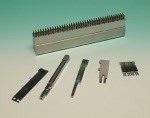High-Precision Mold Shop Cuts EDM Machining Time By 40 Percent
Finally tiring of the tedious cutting times, marginal finishes and excessive secondary operations coupled with automatic wire feeder problems, this mold shop owner sought-and found-an alternative.
Share





Takumi USA
Featured Content
View More
ECi Software Solutions, Inc.
Featured Content
View More

Autodesk, Inc.
Featured Content
View More.png;maxWidth=45)
DMG MORI - Cincinnati
Featured Content
View MoreEDM shops are continuously striving for optimum surface finishes in less and less time, and Goudie Tool & Engineering (Lake Zurich, Illinois) is no exception. For over a quarter century, the 15-man shop has been producing high precision mold inserts for numerous demanding companies—one of which is the nation’s leading manufacturer of electrical connectors. “The materials our customers mold are very abrasive, and consequently their molds take a real beating,” says Ed Goudie, president. “So instant access to replacement parts is a vital necessity. A broken mold insert renders a mold useless and shuts down production, not good in an industry that molds millions upon millions of parts daily. This puts real demands on our shop because more often than not customers demand parts overnight—and they have to fit perfectly. Precision is a must. We’ve even begun producing and stocking some critical ‘problem inserts’ that we can ship immediately.”
As one could guess, Mr. Goudie uses wire EDMs to cut mold inserts, most of which are extremely small and require numerous intricate cuts. “Getting the finishes we needed with the short leadtimes allotted us was tough,” Mr. Goudie says. “Our older wire machines were slow, and getting the required finishes took a minimum of five skim cuts. We roughed out mold inserts, performed the numerous skim cuts and then ground and polished virtually every surface. Everyone knows that excessive polishing just opens the door to inaccuracy. Our initial rough cuts wreaked havoc on workpiece geometry—inside and outside corners, small and large radii, and angles tangent to radii. We had to leave enough stock to accommodate the numerous skim cuts required to meet final finish and geometry. Needless to say, none of this helped improve our throughput.”
Finally tiring of the tedious cutting times, marginal finishes and excessive secondary operations coupled with automatic wire feeder problems, Mr. Goudie sought an alternative. Upon recommendation of his tooling supplier, Mr. Goudie contacted Mike Muraski of Setter Machine, his Midwest Hitachi EDM distributor.
The solution turned out to be an FFII (Fine-Finish) feature—standard on all submersible EDMs from Hitachi Digital Graphics (USA), Inc. (Buffalo Grove, Illinois). Mr. Goudie installed two of the 203RS machines. 203RS is Hitachi’s smallest model. They replaced one older Hitachi and one competitive brand. “Our Hitachi EDMs cut our machining time by 40 to 45 percent,” Mr. Goudie says. “We’ve reduced skim cuts from five down to just two and get better finishes—10 RMS. We now leave just enough offset for the required two skim cuts, confident that finish and geometry will be right. Accuracy is 20 percent better too, and we’ve eliminated half of the secondary grinding operations. Virtually all grinding we do now is non-EDM process related. Mold surfaces just need minor polishing touch-up.” Superior finishes and surface integrity are critical in the production of punch dies and form tools because these characteristics substantially prolong tool life.
Most all of today’s wire EDMs utilize AC power supplies, and Hitachi is no exception. However, the company’s fine finish feature uses a unique conductor tip technology. Upon finish of the rough cut, the conductor tip “pops” out and completely isolates the workpiece from the roughing circuitry. This approach allows the use of low-voltage, high-frequency current delivered through shorter, small diameter “low resistance” wires. The FFII does not need ceramic fixturing for fine finish—ceramic fixturing is costly to manufacture, and use of a ceramic subplate limits workpiece fixturing, reducing the work envelope. MMS
Related Content
Where Micro-Laser Machining Is the Focus
A company that was once a consulting firm has become a successful micro-laser machine shop producing complex parts and features that most traditional CNC shops cannot machine.
Read More6 Machine Shop Essentials to Stay Competitive
If you want to streamline production and be competitive in the industry, you will need far more than a standard three-axis CNC mill or two-axis CNC lathe and a few measuring tools.
Read More5 Tips for Running a Profitable Aerospace Shop
Aerospace machining is a demanding and competitive sector of manufacturing, but this shop demonstrates five ways to find aerospace success.
Read MoreInside the Premium Machine Shop Making Fasteners
AMPG can’t help but take risks — its management doesn’t know how to run machines. But these risks have enabled it to become a runaway success in its market.
Read MoreRead Next
5 Rules of Thumb for Buying CNC Machine Tools
Use these tips to carefully plan your machine tool purchases and to avoid regretting your decision later.
Read MoreBuilding Out a Foundation for Student Machinists
Autodesk and Haas have teamed up to produce an introductory course for students that covers the basics of CAD, CAM and CNC while providing them with a portfolio part.
Read MoreRegistration Now Open for the Precision Machining Technology Show (PMTS) 2025
The precision machining industry’s premier event returns to Cleveland, OH, April 1-3.
Read More






































.jpg;maxWidth=300;quality=90)










